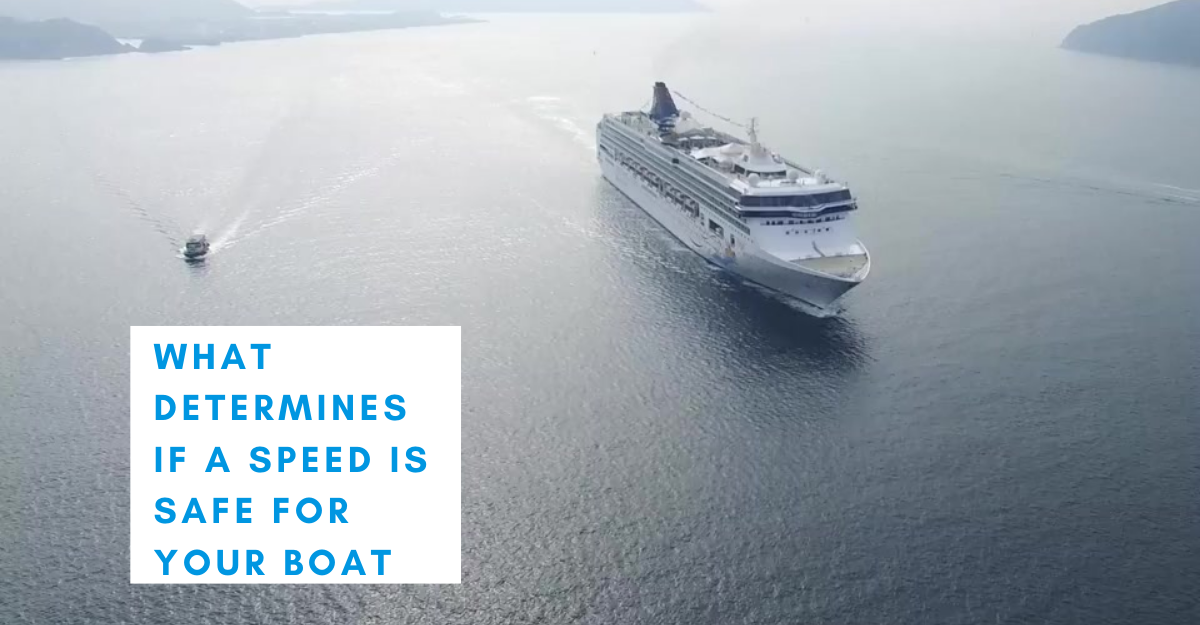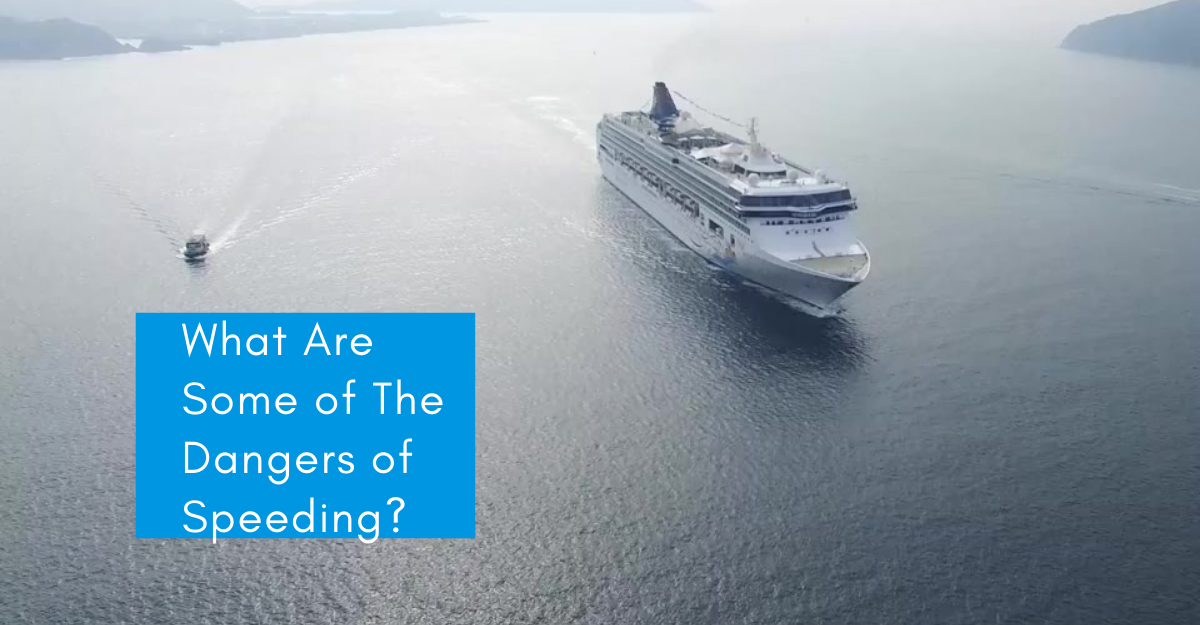
What Determines If A Speed Is Safe For Your Boat?
Determining the safety of a speed for your boat involves various factors and considerations. Firstly, it is essential to assess the condition of your vessel and ensure that all necessary maintenance procedures are regularly performed. One part of a regular vessel and engine maintenance program is conducting routine inspections. By inspecting the hull, engine, propellers, and other crucial components, you can identify any signs of wear, damage, or malfunction that may affect the boat’s performance and safety.
Factors affecting visibility include fog, mist, rain, and darkness. Additionally, the wind, water conditions, and currents also play a role. The density of traffic in the area, the type of vessels present, and their proximity to each other are also important considerations.
Moreover, understanding the limitations of your boat and its specific design is crucial. Each boat has a recommended maximum speed provided by the manufacturer. Exceeding this limit can put excessive strain on the engine, propellers, and other vital parts, potentially leading to mechanical failures or accidents. Therefore, it is crucial to adhere to the manufacturer’s guidelines and ensure that you operate your boat within its recommended speed range.
Furthermore, environmental factors play a significant role in determining a safe speed for your boat. Weather conditions, such as wind, waves, and current, can greatly impact your boat’s stability and maneuverability. Operating at excessive speeds in adverse weather can compromise the safety of your vessel and its occupants. It is important to consider the prevailing weather conditions and adjust your speed accordingly to ensure a safe and comfortable ride.
Lastly, your experience and skill as a boat operator also contribute to determining a safe speed. It is crucial to have a thorough understanding of boating regulations, navigation rules, and proper operating techniques. Adequate training and experience enable you to make informed decisions regarding speed, considering the surrounding conditions and the capabilities of your boat.
In conclusion, ensuring a safe speed for your boat involves a combination of factors. Regular maintenance, adherence to manufacturer recommendations, consideration of environmental conditions, and operator proficiency all contribute to a safe and enjoyable boating experience. By prioritizing these aspects, you can enhance the safety and reliability of your vessel while enjoying the pleasures of being out on the water.
What does Speed mean?
Speed refers to the rate at which an object or vessel moves through a particular distance within a given period. In the context of boating, speed is an important aspect that needs to be carefully managed to ensure a safe and efficient journey on the water. As part of a regular vessel and engine maintenance program, monitoring the performance of the engine is crucial. Engine maintenance involves inspecting and servicing various components, such as the fuel system, cooling system, oil levels, and electrical connections. This proactive approach helps maintain the engine’s optimal functionality, which directly affects the boat’s speed capabilities. By regularly checking and maintaining the engine, you can ensure that it operates smoothly, providing the necessary power to achieve and sustain the desired speed while keeping your vessel and passengers safe.
What does Boat Speed refer to?
Boat speed refers to the velocity at which a boat travels through the water. It is influenced by several factors, including the power of the engine, the boat’s design, the load it carries, and environmental conditions such as wind and currents. To maintain and optimize boat speed, one essential part of a regular vessel and engine maintenance program is propeller maintenance.
The propeller plays a crucial role in determining the boat’s speed and overall performance. Regular inspection and maintenance of the propeller are necessary to ensure its proper functioning. This includes checking for any signs of damage, such as dents, cracks, or bent blades, which can negatively impact efficiency and speed. Additionally, propeller maintenance involves removing any debris or fouling that may have accumulated, such as weeds, fishing lines, or barnacles, as these can impede the propeller’s rotation and reduce boat speed.
Proper propeller maintenance also includes ensuring that it is correctly installed and aligned with the engine. Misalignment or improper installation can result in decreased efficiency, vibration, and potential damage to the propeller and engine.
By incorporating propeller maintenance into a regular vessel and engine maintenance program, boat owners can help maintain optimal boat speed and performance. This, in turn, contributes to a more enjoyable and efficient boating experience while promoting the longevity and reliability of the vessel.
Speed of Travel
Cruising speed refers to the comfortable and efficient speed at which a boat can travel over an extended period. It is the speed at which the boat can maintain a steady course while consuming a reasonable amount of fuel. As part of a regular vessel and engine maintenance program, monitoring and maintaining the fuel system is essential to optimize the boat’s cruising speed.
The fuel system plays a critical role in providing the necessary power to achieve and sustain the desired speed. One part of the maintenance program is inspecting and cleaning the fuel filters regularly. Over time, fuel filters can become clogged with debris, sediment, or contaminants, which can restrict fuel flow and decrease engine performance. By routinely checking and cleaning or replacing the fuel filters, boat owners can ensure that the engine receives clean fuel, allowing it to operate efficiently and maintain the desired cruising speed.
Additionally, it is important to inspect and maintain other components of the fuel system, such as fuel lines and connections. Any signs of leaks, cracks, or deterioration should be addressed promptly to prevent fuel loss and potential safety hazards. Ensuring proper fuel system maintenance not only helps maintain the boat’s cruising speed but also improves fuel efficiency and reduces the risk of engine problems during extended voyages.
By including fuel system maintenance as part of the regular vessel and engine maintenance program, boat owners can optimize their boat’s cruising speed and efficiency, providing a smooth and enjoyable experience on the water while prolonging the life of the engine.
What is Racing Speed?

Racing Speed
Racing speed refers to the maximum velocity at which a boat can travel during competitive racing events. Achieving and sustaining high racing speeds requires meticulous attention to detail in a regular vessel and engine maintenance program. One crucial part of this program is the regular inspection and servicing of the engine’s performance components.
In order to attain racing speed, the engine needs to operate at peak performance. This entails conducting thorough inspections of various components, such as the ignition system, spark plugs, and fuel injectors. These parts must be examined for any signs of wear, damage, or inefficiency that could hinder the engine’s power output. Routine maintenance tasks, like cleaning or replacing spark plugs, adjusting ignition timing, and optimizing fuel delivery, contribute to maximizing the engine’s performance and its ability to propel the boat to its highest racing speed.
Furthermore, a well-maintained cooling system is vital for racing speed. The engine produces a significant amount of heat under high-performance conditions, and a properly functioning cooling system helps dissipate this heat efficiently. Regularly inspecting and cleaning the cooling system’s components, such as the radiator, hoses, and water pump, ensures that they are free from any blockages or leaks that could compromise the engine’s cooling capability.
In addition to the engine, other areas of the vessel also require attention to support racing speed. This may include checking the hull for any damage or imperfections that could increase drag, optimizing the boat’s weight distribution, and ensuring the propeller is in optimal condition.
By incorporating a comprehensive maintenance program that addresses the engine’s performance components and other critical areas of the vessel, boat owners can maximize their boat’s racing speed potential. Regular inspections, cleaning, and adjustments help maintain the engine’s efficiency, reliability, and power output, ultimately enhancing the boat’s competitive performance on the water.
What are the variables that influence the velocity of a boat?
Several factors can influence the speed at which a boat can travel through the water. Understanding and managing these factors are essential for optimizing boat speed. One crucial part of a regular vessel and engine maintenance program is maintaining the hull’s cleanliness.
The condition of the boat’s hull significantly impacts its speed. Over time, marine growth such as algae, barnacles, and other organisms can accumulate on the hull, creating drag and slowing down the boat. Regularly cleaning and inspecting the hull is necessary to ensure its smooth and streamlined surface. This can involve removing any growth, applying anti-fouling paint, and repairing any scratches or imperfections that can hinder the boat’s speed.
Additionally, the boat’s weight and distribution play a significant role in determining its speed. Excessive weight or uneven weight distribution can increase drag and reduce overall performance. As part of the maintenance program, ensuring proper weight management by removing unnecessary items or redistributing the load can help optimize the boat’s speed and efficiency.
Another factor that affects boat speed is the propeller’s condition and selection. The propeller’s size, shape, and pitch impact the boat’s ability to convert engine power into forward thrust. Regularly inspecting the propeller for damage, such as bent blades or dents, and addressing any issues promptly is crucial. Additionally, selecting the right propeller based on the boat’s specifications and intended use is vital for achieving optimal speed.
Environmental factors also influence boat speed. Wind, waves, and current can either assist or hinder the boat’s progress. Understanding how to navigate and utilize these factors to your advantage can impact the boat’s overall speed. However, it is important to note that safety should always be the primary consideration when operating in challenging weather or water conditions.
By including hull maintenance, weight management, propeller care, and consideration of environmental factors as part of a regular vessel and engine maintenance program, boat owners can optimize their boat’s speed and performance. Taking proactive steps to address these factors ensures that the boat operates at its best, providing an enjoyable and efficient experience on the water.
Importance of Speed and Safety in Boating
Boat speed and safety go hand in hand when it comes to navigating the waterways. Maintaining a balance between speed and safety is crucial, and one essential part of a regular vessel and engine maintenance program is the inspection and maintenance of the boat’s steering and navigation systems.
The steering system plays a critical role in maneuvering the boat safely and effectively. Regularly checking the steering components, such as the cables, connections, and hydraulic systems, ensures that they are in good working condition. Any signs of wear, looseness, or damage should be addressed promptly to prevent steering failures that could compromise the safety of the boat and its occupants.
Additionally, the navigation system, including instruments such as the compass, GPS, and depth sounder, must be regularly calibrated and tested. Accurate navigation information is crucial for maintaining proper course and avoiding hazards. Regular maintenance of these systems, including software updates and calibration checks, helps ensure their reliability and accuracy, contributing to safe and precise navigation.
Moreover, part of maintaining boat speed and safety involves keeping the engine in optimal condition. Regular engine maintenance, including oil changes, filter replacements, and inspections, is essential. This helps prevent sudden engine failures that can result in loss of power and control, compromising the safety of the boat and its occupants. Monitoring the engine’s performance indicators, such as temperature and oil pressure, also allows for early detection of potential issues that may affect both speed and safety.
Lastly, maintaining safety equipment is an integral part of any vessel maintenance program. Regularly checking and servicing safety equipment, such as life jackets, fire extinguishers, and distress signals, ensures they are in good working order and easily accessible in case of emergencies. Having well-maintained safety equipment on board enhances the safety of the boat and provides peace of mind for all passengers.
By including the inspection and maintenance of the steering and navigation systems, engine care, and safety equipment as part of a regular vessel and engine maintenance program, boat owners can prioritize both speed and safety. These maintenance practices contribute to a reliable and well-equipped boat, allowing for a smooth and secure boating experience for everyone on board.
What is the method for calculating your speed?
Determining your speed while operating a boat involves utilizing various tools and techniques. One crucial part of a regular vessel and engine maintenance program that assists in determining speed is the proper calibration and maintenance of the boat’s speedometer.
The speedometer is a device that measures the boat’s speed relative to the surrounding water. To ensure accurate readings, it is important to calibrate the speedometer regularly. This calibration process involves comparing the speedometer’s readings to a known distance or GPS measurement. Adjustments can be made if any discrepancies are found, ensuring that the speedometer provides reliable and precise speed information.
In addition to the speedometer, GPS systems are widely used to determine boat speed. GPS devices provide accurate speed readings by utilizing satellite positioning technology. They can display the boat’s speed over ground, which takes into account both the boat’s velocity and any current or tidal effects. GPS-based speed readings are typically more accurate and can be used as a reliable alternative or supplement to the boat’s speedometer.
Furthermore, determining boat speed can also be done through manual calculations using time and distance. By measuring the time it takes to travel a known distance, boat speed can be calculated using the formula: speed = distance/time. This method is commonly used for navigation purposes, especially in situations where speedometer or GPS readings may not be available or reliable.
It is worth noting that accurate speed determination is essential for both efficiency and safety while operating a boat. By ensuring the proper calibration and maintenance of the boat’s speedometer, as well as utilizing GPS systems and manual calculations when needed, boaters can accurately monitor and adjust their speed to meet desired goals and maintain a safe and enjoyable boating experience.
What are the factors that determine a safe speed for a boat?
Several factors come into play when determining a safe boat speed. Safety should always be a top priority while operating a boat, and one crucial part of a regular vessel and engine maintenance program that contributes to safe boat speed is the inspection and maintenance of the boat’s propulsion system.
The propulsion system includes components such as the engine, propeller, and transmission. Regularly inspecting and maintaining these parts ensures they are in proper working condition. This involves checking the engine for any signs of wear or damage, maintaining the appropriate fluid levels, and servicing the propeller to ensure it is free from debris and in good shape. A well-maintained propulsion system helps ensure reliable power delivery, reducing the risk of sudden engine failures or loss of control that can compromise the safety of the boat and its occupants.
Furthermore, environmental factors play a significant role in determining a safe boat speed. Conditions such as wind, waves, and currents can impact a boat’s stability and maneuverability. It is crucial to assess these factors and adjust the speed accordingly. Operating at a safe speed allows the boat to maintain control and stability, minimizing the risk of accidents or capsizing.
Another factor to consider is the boat’s design and capabilities. Each boat has specific limitations and recommended maximum speeds provided by the manufacturer. Exceeding these limits can strain the vessel and its components, compromising safety. Adhering to the manufacturer’s guidelines ensures that the boat operates within its intended capabilities, maintaining a safe boat speed range.
Additionally, the experience and skill of the boat operator play a crucial role in determining a safe speed. Proper training and knowledge of boating regulations and navigation rules enable the operator to make informed decisions regarding speed. Operator proficiency contributes to the overall safety of the boat and its passengers.
By incorporating the inspection and maintenance of the propulsion system, considering environmental factors, adhering to manufacturer recommendations, and prioritizing operator proficiency, boaters can determine a safe speed for their boat. This comprehensive approach helps ensure that the boat operates within its limits, reduces the risk of accidents, and promotes a safe and enjoyable boating experience.
Determining the Appropriate Speed for Your Boat’s Safety
Determining the safe speed for your boat requires a combination of factors that should be considered to ensure a secure and enjoyable boating experience. One essential part of a regular vessel and engine maintenance program that aids in determining the safe speed is the regular inspection and maintenance of the boat’s safety equipment.
Safety equipment plays a crucial role in ensuring the well-being of the boat occupants and should be in good working condition at all times. This includes items such as life jackets, fire extinguishers, distress signals, and navigation lights. As part of the maintenance program, regular inspections and tests should be conducted to ensure that the safety equipment is functional and meets the required standards. Any damaged or expired items should be promptly replaced to ensure their effectiveness in case of emergencies.
Moreover, determining the safe speed for your boat requires considering the specific characteristics of your vessel. Each boat has its unique design, weight, size, and handling capabilities that affect its safe operating speed. Manufacturer guidelines and recommendations should be followed to understand the safe speed range for your particular boat model. Exceeding these limits can compromise stability, maneuverability, and overall safety.
Environmental factors also play a significant role in determining the safe speed. Conditions such as wind, waves, and currents should be carefully evaluated. Operating at a speed that allows for proper control and stability is essential. Adjusting the speed according to the prevailing conditions reduces the risk of accidents and enhances safety.
Furthermore, the experience and skill level of the boat operator contribute to determining a safe speed. Proper training and knowledge of boating regulations, navigation rules, and general boating practices enable the operator to make informed decisions regarding speed. Familiarity with the boat’s handling characteristics and practicing responsible boating behavior are vital for ensuring a safe speed.
By incorporating regular inspection and maintenance of safety equipment, considering manufacturer recommendations, evaluating environmental factors, and prioritizing operator proficiency, boaters can effectively determine the safe speed for their boat. This comprehensive approach promotes a secure boating environment, reduces the risk of accidents, and enhances the overall safety and enjoyment of the boating experience.
Safety rules for maintaining a safe speed on boats.
Boat speed safety rules are essential guidelines to ensure a secure and responsible boating experience. One integral part of a regular vessel and engine maintenance program that contributes to boat speed safety is the regular inspection and maintenance of the boat’s steering and control systems.
The steering and control systems are crucial for maintaining proper control and maneuverability of the boat. As part of the maintenance program, regular inspections should be conducted to check the condition of the steering components, such as cables, connections, and hydraulic systems. Any signs of wear, looseness, or damage should be addressed promptly to prevent steering failures that can lead to loss of control and endanger the safety of the boat and its occupants.
Additionally, the control systems, including throttle and shift controls, should be inspected and maintained regularly. These systems allow the operator to control the boat’s speed and direction. Ensuring that the controls are in good working order, with no sticking or erratic behavior, is crucial for maintaining safe speed adjustments during navigation.
Moreover, part of the boat speed safety rules involves adhering to the posted speed limits and regulations specific to the waterways. Different water bodies may have speed restrictions to ensure the safety of all boaters. It is important to familiarize oneself with these rules and follow them diligently to prevent accidents and maintain a safe boating environment.
Furthermore, operator responsibility and attentiveness play a significant role in boat speed safety. The operator should be aware of their surroundings, constantly scanning for potential hazards, and adjusting the speed accordingly. This includes considering factors such as proximity to other boats, navigational obstacles, and the presence of swimmers or divers. Adhering to a safe speed based on the prevailing conditions and maintaining a proper lookout contribute to overall boating safety.
By incorporating regular inspection and maintenance of the steering and control systems, following speed limits and regulations, and practicing responsible boating behavior, boaters can adhere to boat speed safety rules. This comprehensive approach promotes a secure boating environment, reduces the risk of accidents, and ensures the safety of both the boaters and other individuals sharing the waterways.
What are a few of the hazards associated with driving at excessive speeds?

What are a few of the hazards associated with driving at excessive speeds?
Speeding while operating a boat can pose various dangers and risks to both the occupants of the vessel and others sharing the waterways. Recognizing these dangers is crucial for promoting boating safety. One important part of a regular vessel and engine maintenance program that helps mitigate the dangers of speeding is the inspection and maintenance of the boat’s braking and stopping systems.
Insufficient braking and stopping capabilities can significantly contribute to accidents and collisions while boating. Regular inspection and maintenance of the braking system are essential to ensure its proper functioning. This includes checking the condition of brake pads, calipers, rotors, and hydraulic systems. Any signs of wear, damage, or malfunction should be promptly addressed to maintain effective braking performance and improve the ability to stop the boat safely.
One of the primary dangers of speeding is reduced maneuverability and control. Operating a boat at high speeds decreases the amount of time available to react to obstacles, other vessels, or changing conditions. This can lead to difficulties in making timely course adjustments, avoiding collisions, or navigating narrow channels. Reduced maneuverability increases the risk of accidents and endangers the safety of both the occupants and others in the vicinity.
Additionally, speeding amplifies the impact and severity of accidents. Higher speeds result in increased kinetic energy, making collisions more forceful and potentially causing more significant damage and injuries. The risk of injuries from falls or being thrown overboard also rises with higher speeds. The impact of such accidents can be mitigated by adhering to safe speeds and allowing for proper reaction time and control.
Speeding can also create hazardous wake effects. The waves generated by a speeding boat can cause instability for smaller vessels, watercraft, or individuals nearby. Excessive wake can lead to swamping, capsizing, or collisions with other vessels or structures. By maintaining appropriate speeds, boaters can minimize the risk of creating dangerous wakes and ensure the safety of others in the area.
By recognizing the dangers of speeding, and incorporating regular inspection and maintenance of the boat’s braking and stopping systems, boaters can prioritize safety and minimize the risks associated with excessive speed. Responsible boating behavior, including adhering to speed limits and adjusting speeds based on conditions, helps create a safe and enjoyable boating environment for everyone involved.






